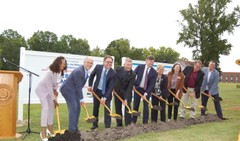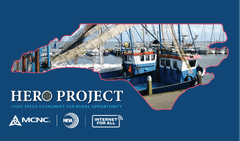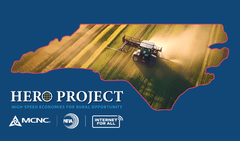HERO Project: Expanding broadband helps North Carolina stay ahead of the storm

The MCNC HERO (High Speed Economies for Rural Opportunities) Project aims to ensure every community in North Carolina has what it needs to fully participate in today’s society.
MCNC's continuous investments in expanding and upgrading its network shows just how important broadband is for many aspects of modern life – and in the Carolinas it’s well known how important it is to be prepared for all sorts of weather events and disasters – especially during hurricane season.
Active Hurricane Season in the Forecast
The National Oceanic and Atmospheric Administration (NOAA) released its updated Atlantic Hurricane Season Outlook on May 23, predicting above-normal hurricane activity this season, which spans from June 1 to Nov. 30.
The above-normal activity is due to a confluence of factors, including near-record warm ocean temperatures in the Atlantic, development of La Niña conditions in the Pacific, and reduced Atlantic trade winds and less wind shear. NOAA is forecasting a range of 17 to 25 total named storms (winds of 39 mph or higher). Of those, 8 to 13 are forecast to become hurricanes (winds of 74 mph or higher), including 4 to 7 major hurricanes (Category 3, 4 or 5; with winds of 111 mph or higher).
NOAA noted 70 percent confidence in these forecast ranges.
Storm Names and History of Operational Readiness
Since 1953, Atlantic tropical storms had been named by the National Hurricane Center, which are now maintained by the World Meteorological Organization. Lists are used in rotation and recycled every six years (i.e., the 2023 list will be used again in 2029). The only time there is a change is if a storm is so deadly or costly that the use of its name for a different storm would be inappropriate.
There have been 96 storm names retired since the lists began. No names were retired in 2023 with eight officially retired this decade (2020s) so far, with the most recent being Hurricane Ian in 2022. Some of the most destructive hurricanes to hit the United States were recorded in the 2010s, a decade in which 30 named storms were classified as major hurricanes out of the 152 named storms. Altogether, 16 names were retired that decade. Hurricane Florence in 2018 was one of those storms, which devastated parts of Eastern North Carolina after making landfall just south of Wilmington on Sept. 13. Even though at impact it had been reduced to a Category 1 storm, Florence hit the coast with high winds and record amounts of rain. At least 55 deaths were attributed to the storm and property damage and economic loss estimated at almost $17 billion in North Carolina.
When all the hurricanes and tropical storms that formed in the Atlantic and eastern Pacific oceans in 2018 were added together, the 2018 hurricane season was the most active season on record. And, MCNC was operationally ready during that historic year and has continued to refine processes, contingency and disaster planning, and network redundancy to be even more prepared every year.
Lending High-Speed Hands in Times of Need
Hurricane Florence's slow trot over North and South Carolina in September 2018 was another major disaster for FEMA to contend with that year. Facing damage over hundreds of square miles, FEMA called upon MIT Lincoln Laboratory to use their Lidar system to image the destruction of the region.
MCNC provisioned a 10-gigabit IP connection from its network to Internet2 and made it possible for Lincoln Laboratory to process its Lidar data without delay. Read: Lidar scans over the Carolinas accelerate hurricane recovery. This is just one of many examples over the years how MCNC leverages its network, resources and expertise to help others in North Carolina. The HERO Project in particular will further expand capabilities in coastal areas like the ones impacted by Florence.
Supporting Big Data Improves Prediction Models
The U.S. National Climatic Data Center (NCDC) in Asheville was the world's largest active archive of weather data. In 2015, the NCDC merged with two other federal agencies to become the National Centers for Environmental Information (NCEI). The NCEI’s role as the primary environmental archive for NOAA captures and disseminates an astounding amount information and daily basis, and MCNC helps to make sure that data continues to be captured in real-time and is safe.
In 2011, the now NCEI received two 10G broadband connections as part of the build-out of the of Golden LEAF Rural Broadband Initiative administered through MCNC – read case study. That connection was a significant upgrade from the two 1G connections previously used. Over a 10-year period since that upgrade, NCEI's digital archive experienced a six-fold increase from 1 petabyte to 6 petabytes. With increasing sophistication of data collection equipment, data was expected to exceed 14 petabytes by 2020. As of late 2023, according to recent reporting from NCEI, they were responsible for more than 60 petabytes of data with further growth expected in the coming years.
Broadband Before, During and After the Storm
High-speed internet now plays a crucial role during hurricane season in North Carolina.
Before the storm, access to weather updates, evacuation information, and emergency preparedness resources is vital. Broadband allows for downloading hurricane tracking information, staying informed on official instructions, and making informed decisions. Broadband also enables communication through phone calls, texts, emails, and social media platforms as well as help secure your home – smart home devices connected to the internet can be used remotely to adjust thermostats, lock doors, and monitor security cameras even if you've evacuated.
During the storm, broadband can be a lifeline for critical communication. Even with limited electricity in most cases, some devices like laptops or smartphones can still be used to access essential news updates and information about the storm's progress and potential dangers. After the storm, broadband access allows you to quickly assess the situation in your area, check on friends and family, and see if there are any updates on power restoration or emergency services availability. You also can report damage to your property or request help from emergency services through online platforms or phone calls facilitated by broadband. Accessing online banking and financial resources might be crucial during the recovery phase as well as connecting with insurance carriers.
Broadband can be a valuable tool for staying informed, connected and prepared throughout hurricane season. Remember to prioritize safety and follow official instructions during storms, but broadband can serve as a helpful resource in the hurricane preparedness process.
It All Adds Up
In just the last five years, MCNC has invested more than $60 million in the proper upkeep and expansion of its network, including the HERO Project at roughly $19 million. Once this project is complete, it will extend MCNC’s reach with another 209 miles of new middle-mile fiber through substantially unserved and underserved areas, including some of the highest poverty areas in the state. This level of ongoing commitment allows MCNC to customize network services and applications while cost-effectively meeting the bandwidth needs of North Carolina communities.
Investing in broadband infrastructure is an investment in the future, and the HERO Project is part of a long-term endeavor to protect as well as unlock the full potential of everyone in North Carolina.
Construction is expected to begin this summer with completion planned for June 2025.




















